Intel X25-V in RAID-0: Faster than X25-M G2 for $250?
by Anand Lal Shimpi on March 29, 2010 8:59 PM ESTMissing TRIM - Does it Matter?
Clearly the performance of two X25-Vs in RAID 0 is great, but you do lose TRIM - isn't that a dealbreaker? Honestly, it depends. For sequential accesses, TRIM isn't necessary on the Intel drives. The X25 controller does a good job of aggressively cleaning and recycling NAND blocks and you'll pretty consistently write at peak performance if your workload is almost all sequential.
The more random your access pattern is, the more you'll miss TRIM. Thankfully desktops don't spend too much of their time randomly writing data across the drive, but I'd say a good 30% of most desktop writes are random to an extent. Over time, these random writes will build up and bring down the overall performance of your RAID array until you either secure erase the drives or write sequentially to all available free space.
There is one other option for curbing the performance degradation before it happens. Remember the relationship between spare area and write amplification:
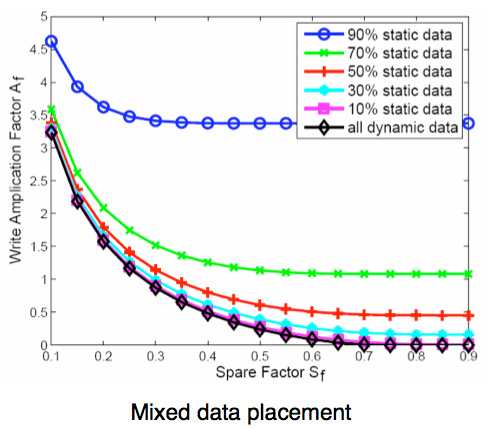
The more random your workload, the higher your write amplification (and thus the lower your performance, shorter your NAND lifespan). Increasing spare area can go a long way to reducing write amplification. While it can't eliminate it, it can definitely make a dent.
If you're looking to keep performance as high as possible with a pair of X25-Vs in RAID, you can always allocate more NAND as spare area. Secure erase each drive, create your RAID array, and then create your partition on the drive smaller than max capacity (try 10 - 20% smaller). The unpartitioned space should automatically be used by the controller as spare area. To test the effectiveness of this approach I took an X25-V, filled it with garbage data, and then wrote random data across the drive as fast as possible for 20 minutes. I then ran HD Tach to get a visualization of write latency (expressed by sudden drops in bandwidth) vs. LBA:
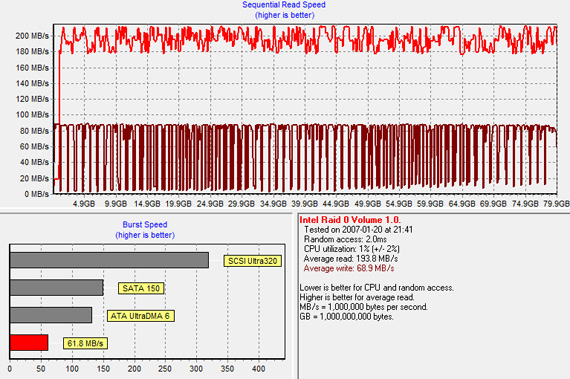
A standard 80GB X25-M wouldn't be this bad off, the X25-V gets extra penalized by having such a limited capacity to begin with. You can see that the drive is attempting to write at full speed but gets brought down to nearly 0MB/s as it has to constantly clean dirty blocks. Constant TRIMing would never let the drive get into this state. It's worth mentioning that a desktop usage pattern shouldn't get this happen either. Another set of sequential writes will clean up most of this though:
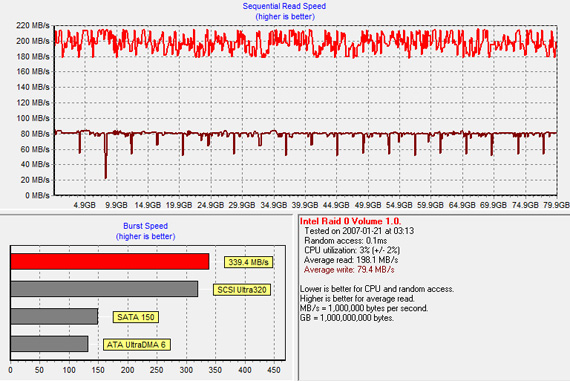
Intel's controller is very resillient. Even without TRIM, as long as your access pattern has some amount of a sequential component you'll be able to eventually recover performance.
Now look at what happens if we only use 60GB of the 74.5GB RAID 0 array upon creation and run the same test:
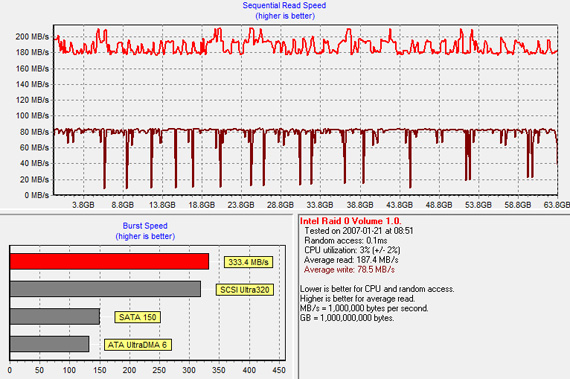
Performance isn't nearly as bad. That added spare area really comes in handy. Of course another pass corrects nearly everything:
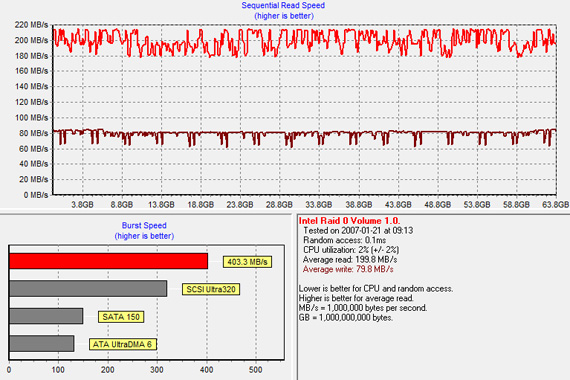
If you don't need the added space, using a smaller partition is a great way to ensure high performance for as long as possible. The effectiveness of this approach is a difficult thing to benchmark given that it's only after months of normal use that you get enough random writes to the drive to be a problem. The good news is that even if you bombard the X25-Vs with random writes, the drives can quickly recover as soon as they're hit with some sequential data.










87 Comments
View All Comments
GullLars - Thursday, April 1, 2010 - link
I think TRIM works i IDE mode also, i remember reading that both drivers PCIIDE and MSAHCI supports TRIM. However, this is not the big problem with using IDE mode, the problem is the loss of NCQ, so your performance don't scale with load. Your SSD will essentially only be able to do about 20MB/s at 4KB random read, while it can do 120MB/s random read with NCQ enabled (at fairly high load, like launching multiple apps simultaneously).buzznut - Thursday, April 1, 2010 - link
Thanks for the reply. I have been considering getting a new mobo anyway, I think I'd like to get a 890gx with the new interfaces.Only pb there is I have ddr2 ram and am2 cpus. doh
Guess I'll wait til some money comes in to do any upgrading...
Elganja - Friday, April 2, 2010 - link
"Update (03/29/2010): Intel has recently released a new driver that allows Windows 7’s TRIM instructions to be passed through the Southbridge. The new driver is labeled "Rapid Storage Technology 9.6" and it can be found here. These drivers are also able to pass TRIM commands to RAID 0 and RAID 1 arrays. "jed22281 - Saturday, April 3, 2010 - link
TT is mistaken, there is no support for drives combined into RAID volumes.There is for individual drives connected to the controller while it's in RAID mode.
http://www.intel.com//support/chipsets/imsm/sb/CS-...
Also see
http://communities.intel.com/community/tech/solids...
Look for the gold star at the top of the page, select show details and then go to announcement 2.
"Intel® RST 9.6 supports TRIM in AHCI and pass through modes for RAID. A bug has been submitted to change the string that indicates TRIM is supported on RAID volumes (0, 1, 5, 10). Intel is continuing to investigate the ability of providing TRIM support for all RAID volumes in a future release."
Chloiber - Sunday, April 4, 2010 - link
A colleague from another HW site asked Intel directly. It's definitely NOT SUPPORTED (just to point that out again). It's clearly a mistake of intel, as they didn't make themselves clear in the change logs/readmes and even in the rapid storage manager itself it's not clear.Here is what they said btw:
"It will support TRIM with SSDs in an AHCI configuration, or with the RAID controller enabled and the SSD is used as a pass through device. An example of this use case is for users that want to use the SSD as a boot drive but still be able to RAID multiple HDDs together to allow for large protect data storage – a great use for the home theater PC."
No RAID0 or anything. "Just" simple TRIM as we're used to from the MSAHCI drivers.
Elganja - Friday, April 2, 2010 - link
The quote was from this article: http://www.tweaktown.com/articles/3116/tweaktown_s...morphin1 - Friday, April 2, 2010 - link
What do you mean by doing sequential write?How would you do that?
Also will this apply to the new Sony Vaio Z series laptops SSD's that come in Raid 0 config?
Is it recommended to buy a laptop in Raid 0 config with SSD's as over time they might become snails.
Do you see the chance of Trim being supported on current SSD's in the near future?
Thanks a lot in advance.
GullLars - Saturday, April 3, 2010 - link
Sequential writes are the type of writes that typically occur when you save or copy large files (1MB or larger).As for RAID in sony Vaio. There is no way of telling if it will become snail-like whitout knowing wich SSD is in the laptop in question. If it's Intel, Sandforce, or C300, it sould be just fine, if it's some low-quality cheap SSD from last generation drives, or the crap they put in the netbooks last year, it will go really bad.
jed22281 - Saturday, April 3, 2010 - link
You mean if it's:Postville (Intel), SF-1200/1500 (Sandforce), C300 (JMicron), or Barefoot (Indilinx)
GullLars - Saturday, April 3, 2010 - link
I forgot barefoot, my bad.